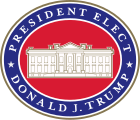Donald Trump presidential transition
 |
|

President Barack Obama (left) and President-elect Donald Trump (right) meet in the Oval Office of the White House as part of the Presidential transition
|
|
| Predecessor | Donald J. Trump for President |
|---|---|
| Formation | May 9, 2016 |
| Extinction | January 20, 2017 |
| Legal status | 501(c)(4) |
| Purpose | Presidential transition |
| Headquarters | 1717 Pennsylvania Avenue NW, Washington, D.C., United States |
|
Chairman
|
Mike Pence |
|
Director of Appointments
|
William F. Hagerty |
|
Key people
|
Donald Trump |
| Website | greatagain |
Planning for the presidential transition of Donald Trump, led by then Vice President-elect, former Governor Mike Pence of Indiana, began before Donald Trump won the United States presidential election on November 8, 2016, and became the President-elect. Trump was formally elected by the Electoral College on December 19, 2016. The transition was formerly led by Chris Christie until he and a number of his supporters were replaced or demoted on November 11. The transition ended when Trump was inaugurated at noon EST on January 20, 2017.
In accordance with the Pre-Election Presidential Transition Act of 2010, candidate transition teams are provided office space by the General Services Administration (GSA). Transition teams are also eligible for government funding for staff; spending on Mitt Romney's transition team in 2012 was $8.9 million, all funds appropriated by the U.S. government.
Under existing federal law and custom, the Republican Party's nominee became eligible to receive classified national security briefings once his/her nomination was formalized at the party's national convention.
Key responsibilities of a presidential transition include the identification and vetting of candidates for approximately 4,000 non-civil service positions in the U.S. government whose service is at the pleasure of the president; arranging the occupancy of executive residences including the White House, One Observatory Circle, and Camp David; liaising with the United States Strategic Command for receipt of the Gold Codes; and briefing senior civil service personnel about a new administration's policy priorities.
...
Wikipedia
